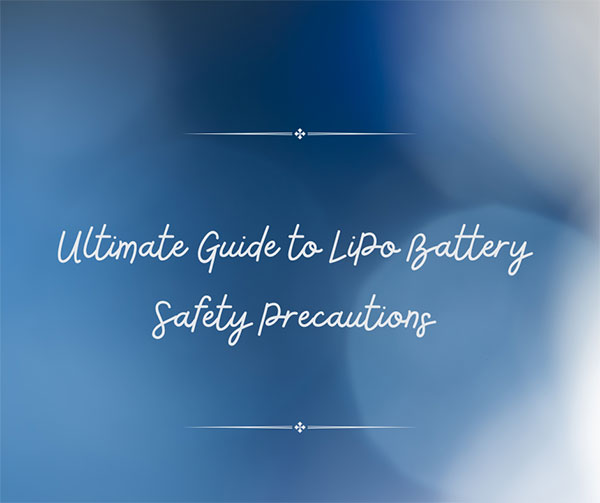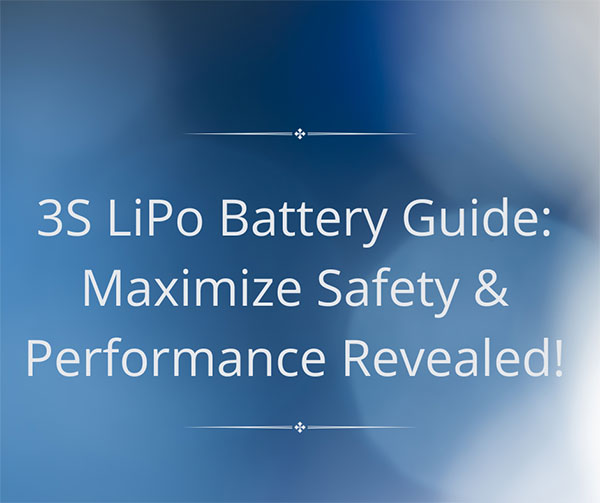Ultimate Guide to LiPo Battery Safety Precautions


Lithium polymer (LiPo) batteries are powerful, lightweight, and commonplace in devices like drones, electric vehicles, laptops, tablets, and more. However, they also pose fire and explosion risks if not handled properly. This guide covers crucial safety measures for charging, discharging, storing, transporting, and disposing of LiPo batteries. Follow these precautions closely to prevent catastrophic battery failures.
What are LiPo Batteries?
LiPo batteries are a type of rechargeable lithium-ion battery that utilizes a polymer electrolyte and layered cathode/anode design. This gives them a high power-to-weight ratio, low self-discharge, high current output, and customizable form factors. They contain flammable electrolyte solutions making them volatile if manufactured or used incorrectly.
Advantages of LiPo Batteries
Compared to other battery chemistries, LiPos have key advantages:
- Lightweight and compact
- High capacities able to store lots of energy
- Output high discharge currents
- Low self-discharge rates
- Customizable shapes and sizes
- High cell voltages around 3.7V (nominal)
These attributes make them well suited for drones, R/C vehicles, laptops, mobile devices, electric vehicles, and other applications requiring robust portable power.
Disadvantages and Risks of LiPo Batteries
However, LiPo batteries come with safety trade-offs:
- Overheating can cause thermal runaway leading to fire or explosion
- Must use proper chargers - incorrect voltages damage cells
- Over-discharging damages batteries
- Impact damage can trigger short circuits
- Requires special handling when transporting and storing
In short, exercising caution is mandatory for LiPo safety. Let's explore specific precautions to mitigate these hazards.
Proper Charging Techniques
Charging is one of the most critical processes for LiPo batteries - improper handling here heightens danger significantly.
Use the Right Charger
Only use a smart charger designed explicitly for LiPo cells. These regulate voltages, currents, and charging modes correctly. Chargers for other battery types may overcharge LiPos posing fire risks. Select a charger aligned with your battery specifications.
Don't Leave Charging Unattended
Stay nearby cells charging. This allows promptly removing them once fully charged preventing overheating or swelling. Damaged batteries must be discharged fully before disposal (more below).
Charge in a Fireproof Container
Always place batteries in fireproof LiPo charging bags or metal containers when charging. This gives an added layer of protection if leakage or thermal runaway does occur. Never charge LiPos loosely on flammable surfaces.
Follow Manufacturer Guidelines
Adhere to the battery manufacturer's recommended charge rates and voltage limits. Charging outside these bounds stresses cells and can prompt failures. Most LiPos charge to 4.20V per cell at 1C or less.
Proper Voltage Handling
In addition to charging, general voltage parameters also require diligence for safety.
Don't Drain too Low
Discharging LiPo cells too low damages them through a loss of performance and shortened lifespan. LiPos should not fall below 3.0V per cell under load. Setting low-voltage cutoffs on electronics prevents excessive drainage.
Avoid Over-Charging
Similarly, charging over 4.20V per cell degrades batteries. As mentioned, using LiPo-suitable smart chargers mitigates this. Never try charging with a mismatched charger.
Storage Charge when Not in Use
For storage exceeding a few days, LiPos should maintain a partial charge around 3.80V to 3.85V per cell. This slows chemical aging effects during inactivity. Fully draining or charging for storage amplifies wear.
Safe Transportation and Storage
Best practices around transport and storage also help avert mishaps.
Use Protective Cases
LiPo cells stay inside hard shell transport cases whenever moving them. Foam inserts prevent shifting and contacts between cells/terminals. This protects against accidental impacts or drops which could ignite fires. Cases also contain failures.
Store at Room Temperature
Avoid temperature extremes during storage like vehicles or garages exposing batteries to excessive heat or cold. Store LiPos between 60-80°F in dry rooms for optimal lifespan. Elevated temperatures accelerate aging effects.
Isolate Batteries During Transport
Never transport loose LiPo batteries alongside flammable objects, liquids, gases, or oxidizers where accidental leakage could trigger catastrophic ignitions. Keep them securely separated from potential fuels. Use fireproof containers to add redundancies if transporting many cells.
Proper Disposal
At end-of-life when LiPos no longer recharge sufficiently, they must undergo safe disposal too:
Discharge Fully First
Deplete dead batteries to 0V no longer posing ignition threats when opening for recycling separation. Various low voltage dischargers safely dissipate remaining charges.
Tape Terminal Ends
After a full discharge, place insulation tape over the positive and negative terminals as an extra precautionary measure blocking contact.
Recycle Properly
With terminals covered, recycling centers can safely dismantle battery packs separating out lithium, copper, aluminum, and plastic compounds for recovery. Search for LiPo recycling locations in your region to dispose of them responsibly. Discarded LiPos cause environmental hazards otherwise.
What to Do in Case of Fire
Despite meticulous safety measures, LiPo failures resulting in fires may still arise on occasion. Prepare emergency action plans just in case:
Have an Extinguisher Ready
Keep a Type D fire extinguisher designed for lithium, magnesium, and metal fires nearby any LiPo charging or storage areas. This allows immediately suppressing any ignitions before spreading. Water extinguishers must not get used initially to avoid spreading organics or hot flammable electrolytes.
Submerge in Salt Water
For batteries already engulfed in flames seemingly uncontainable, plunge them fully into salt water if safely possible. The sodium chloride bonds with lithium ions helping displace oxygen and extinguishing the fire once completely submerged. Use large containers and avoid inhaling potentially toxic fumes.
Contact Emergency Services
If unable to suppress a LiPo fire through an extinguisher or salt bath, evacuate the area while dialing emergency responders to assist. Fires can release hydrofluoric acid or toxic carbonyl fluoride gases amid burning electrolytes. Let professionals tackle uncontrolled LiPo fires rather than inhaling hazardous combustion byproducts.
Conclusion
LiPo batteries enable powering cutting-edge electric devices - but demand responsible safety habits given fire susceptibility. Follow these best practices around charging, discharging, storage, transportation, disposal and fire containment. Taking prudent precautions will ensure benefiting from LiPo capabilities without nasty explosive mishaps. Operated carefully, they safely unlock innovation through high-performance mobile energy solutions.
FAQs
Q: Can LiPo batteries explode?
Yes - if improperly charged, discharged, damaged, or otherwise mishandled, thermal runaways can build cumulatively in LiPo batteries leading to explosions and intense fires. Strict usage guidelines aim to prevent these hazardous scenarios.
Q: How long do LiPo batteries last?
Around 300-500 charge cycles if cared for appropriately. Heat, deep discharging, and high current draws degrade lifespan. Storage charges between uses preserves longevity.
Q: What happens if a LiPo battery gets punctured?
Puncturing the protective casing exposes highly flammable electrolytes which can ignite fires upon contacting air. If a LiPo gets damaged, place it in salt water after fully discharging. Recycle once safe rather than continuing to use a compromised battery.
Q: Can LiPo batteries go in checked luggage on a plane?
No - almost all airlines prohibit transporting lithium batteries in checked baggage given fire risks. Only carry them in carry-on bags so any issues get identified quickly in flight. Batteries must stay protected in retail packaging orsecured cases.
Q: Do LiPo batteries need special disposal?
Yes - dead LiPos classified as hazardous e-waste must go through professional recycling facilities rather than standard trash disposal. Most jurisdictions forbid landfilling used lithium batteries since soil contamination and groundwater pollution may occur otherwise. Fully discharge and tape terminals before drop-off recycling.



